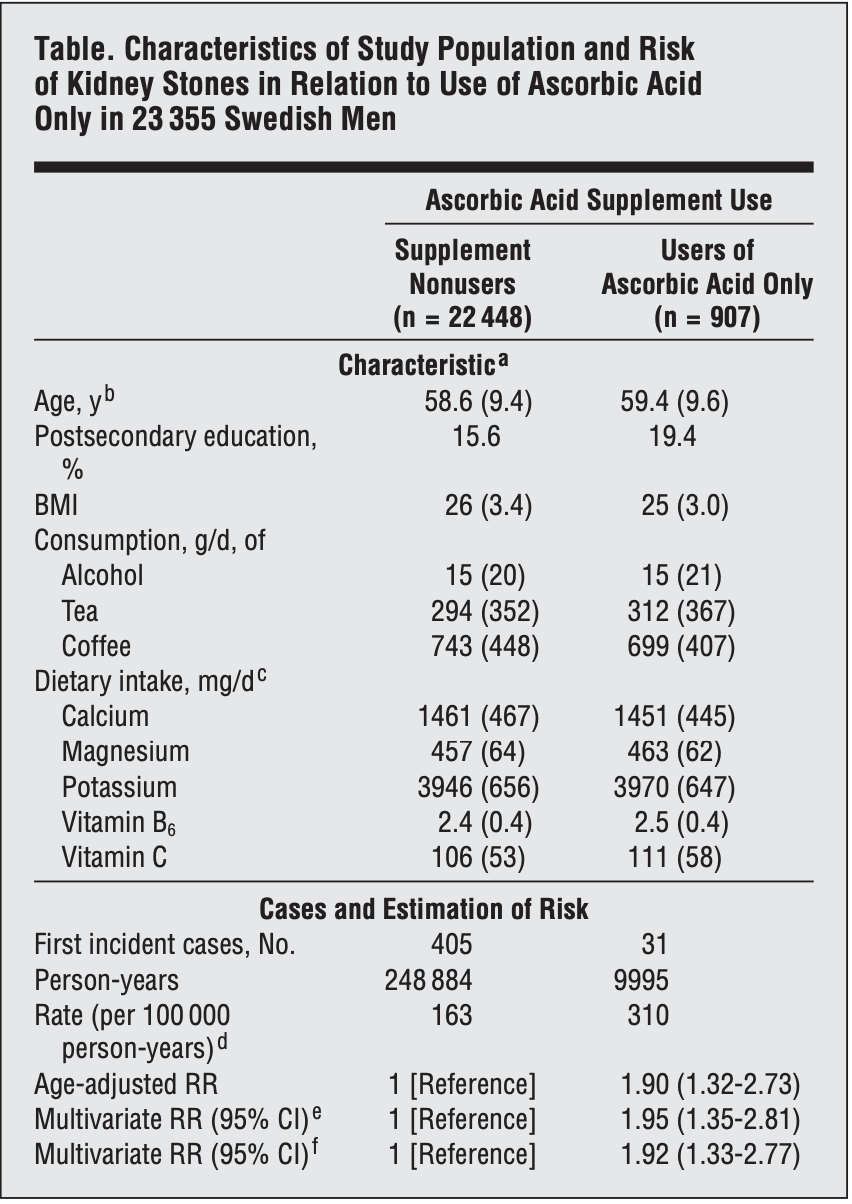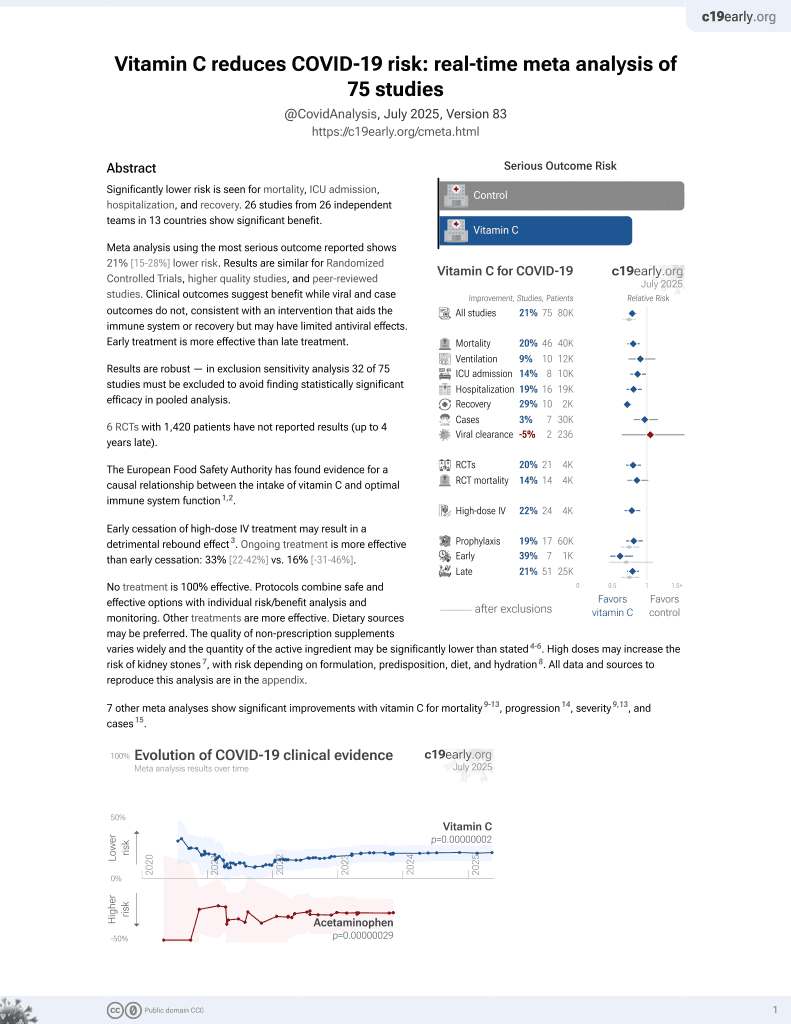
Ascorbic Acid Supplements and Kidney Stone Incidence Among Men: A Prospective Study
et al., JAMA Internal Medicine, doi:10.1001/jamainternmed.2013.2296, Mar 2013
Vitamin C for COVID-19
6th treatment shown to reduce risk in
September 2020, now with p = 0.00000002 from 75 studies, recognized in 22 countries.
No treatment is 100% effective. Protocols
combine treatments.
6,300+ studies for
210+ treatments. c19early.org
|
Prospective study of 23,355 Swedish men showing a 2-fold increased risk of kidney stone formation with high-dose ascorbic acid supplement use. Authors note that ascorbic acid is excreted in urine both unmetabolized and as oxalate, which is a key factor in calcium oxalate kidney stone formation.
Thomas et al., 11 Mar 2013, Sweden, peer-reviewed, 5 authors.
Contact: agneta.akesson@ki.se.
The Status of Baby Boomers' Health in the United States
JAMA Internal Medicine, doi:10.1001/jamainternmed.2013.2006
Figure] ), and medication use for hypercholesterolemia was more than 10 times greater (25.9% vs 1.5%; PϽ.001). Baby boomers were also more likely to have diabetes (15.5% vs 12.0%; P = .003 [Figure]) and take medication for diabetes (11.3% vs 6.2%; P Ͻ .001). The slight trend toward higher prevalence of cancer in baby boomers vs the previous generation was not significant (10.6% vs 9.5%; P = .25). The frequency of emphysema decreased in the baby boomer generation (2.3%) relative to the previous generation (3.5%) (P = .03). Baby boomers were also less likely to have had a myocardial infarction (3.6%) compared with the previous generation (5.3%) (P=.004). A logistic regression was conducted to control for changes in demographic characteristics (age, sex, race, and socioeconomic status) of the population between 1988-1994 and 2007-2010. The results indicated, after adjustment, that baby boomers remained more likely than the previous generation to have diabetes (odds ratio [OR], 1.46; 95% CI, 1.16-1.83); hypertension (OR, 1.38; 95% CI, 1.14-1.67); and hypercholesterolemia (OR, 5.94; 95% CI, 4.94-7.14). Comment. Despite their longer life expectancy over previous generations, US baby boomers have higher rates of chronic disease, more disability, and lower self-rated health than members of the previous generation at the same age. On a positive note, baby boomers are less likely to smoke cigarettes and experience lower rates of emphysema and myocardial infarction than the previous generation. The findings from the present study documenting poorer health status and increased rates of obesity, hypertension, diabetes, and hypercholesterolemia support an increased likelihood for continued rising health care costs and a need for increased numbers of health professionals as baby boomers age. 5,6 Given the link between positive healthy lifestyles and subsequent health in this age group, 7 the present study demonstrates a clear need for policies that expand efforts at prevention and healthy lifestyle promotion in the baby boomer generation.
Role of the Sponsors: The funders had no role in the design and conduct of the study; in the collection, analysis, and interpretation of the data; or in the preparation, review, or approval of the manuscript. Previous Presentation: This study was presented as a conference poster, "Vitamin C Supplementation and Kidney Stone Incidence Among Men: A Population-Based Prospective Cohort Study," at the International Conference on Diet and Activity Methods, Food and Organisation; May 15, 2012; Rome, Italy.
References
Bjelakovic, Nikolova, Gluud, Simonetti, Gluud, Antioxidant supplements for prevention of mortality in healthy participants and patients with various diseases, Cochrane Database Syst Rev
Curhan, Willett, Speizer, Stampfer, Twenty-four-hour urine chemistries and the risk of kidney stones among women and men, Kidney Int
King, Mainous, Iii, Geesey, Turning back the clock: adopting a healthy lifestyle in middle age, Am J Med
Martin, Freedman, Schoeni, Andreski, Health and functioning among baby boomers approaching 60, J Gerontol B Psychol Sci Soc Sci
Messerer, Ha ˚kansson, Wolk, Akesson, Dietary supplement use and mortality in a cohort of Swedish men, Br J Nutr
Messerer, Johansson, Wolk, The validity of questionnaire-based micronutrient intake estimates is increased by including dietary supplement use in Swedish men, J Nutr
Messerer, Wolk, Sensitivity and specificity of self-reported use of dietary supplements, Eur J Clin Nutr
Olshansky, Goldman, Zheng, Rowe, Aging in America in the twentyfirst century: demographic forecasts from the MacArthur Foundation Research Network on an Aging Society, Milbank Q
Rice, Fineman, Economic implications of increased longevity in the United States, Annu Rev Public Health
Ricketts, The health care workforce: will it be ready as the boomers age? a review of how we can know (or not know) the answer, Annu Rev Public Health
Sturm, Ringel, Andreyeva, Increasing obesity rates and disability trends, Health Aff (Millwood)
Taylor, Stampfer, Curhan, Dietary factors and the risk of incident kidney stones in men: new insights after 14 years of follow-up, J Am Soc Nephrol
Tiselius, Solution chemistry of supersaturation
DOI record:
{
"DOI": "10.1001/jamainternmed.2013.2296",
"ISSN": [
"2168-6106"
],
"URL": "http://dx.doi.org/10.1001/jamainternmed.2013.2296",
"author": [
{
"affiliation": [],
"family": "Thomas",
"given": "Laura D. K.",
"sequence": "first"
},
{
"affiliation": [],
"family": "Elinder",
"given": "Carl-Gustaf",
"sequence": "additional"
},
{
"affiliation": [],
"family": "Tiselius",
"given": "Hans-Göran",
"sequence": "additional"
},
{
"affiliation": [],
"family": "Wolk",
"given": "Alicja",
"sequence": "additional"
},
{
"affiliation": [],
"family": "Åkesson",
"given": "Agneta",
"sequence": "additional"
}
],
"container-title": "JAMA Internal Medicine",
"container-title-short": "JAMA Intern Med",
"content-domain": {
"crossmark-restriction": false,
"domain": []
},
"created": {
"date-parts": [
[
2013,
2,
4
]
],
"date-time": "2013-02-04T18:33:49Z",
"timestamp": 1360002829000
},
"deposited": {
"date-parts": [
[
2016,
12,
16
]
],
"date-time": "2016-12-16T22:34:57Z",
"timestamp": 1481927697000
},
"indexed": {
"date-parts": [
[
2024,
11,
19
]
],
"date-time": "2024-11-19T16:39:55Z",
"timestamp": 1732034395168
},
"is-referenced-by-count": 85,
"issue": "5",
"issued": {
"date-parts": [
[
2013,
3,
11
]
]
},
"journal-issue": {
"issue": "5",
"published-print": {
"date-parts": [
[
2013,
3,
11
]
]
}
},
"language": "en",
"link": [
{
"URL": "http://jamanetwork.com/journals/jamainternalmedicine/fullarticle/1568519",
"content-type": "unspecified",
"content-version": "vor",
"intended-application": "similarity-checking"
}
],
"member": "10",
"original-title": [],
"page": "386",
"prefix": "10.1001",
"published": {
"date-parts": [
[
2013,
3,
11
]
]
},
"published-print": {
"date-parts": [
[
2013,
3,
11
]
]
},
"publisher": "American Medical Association (AMA)",
"reference-count": 0,
"references-count": 0,
"relation": {},
"resource": {
"primary": {
"URL": "http://archinte.jamanetwork.com/article.aspx?doi=10.1001/jamainternmed.2013.2296"
}
},
"score": 1,
"short-title": [],
"source": "Crossref",
"subject": [],
"subtitle": [],
"title": "Ascorbic Acid Supplements and Kidney Stone Incidence Among Men: A Prospective Study",
"type": "journal-article",
"volume": "173"
}
